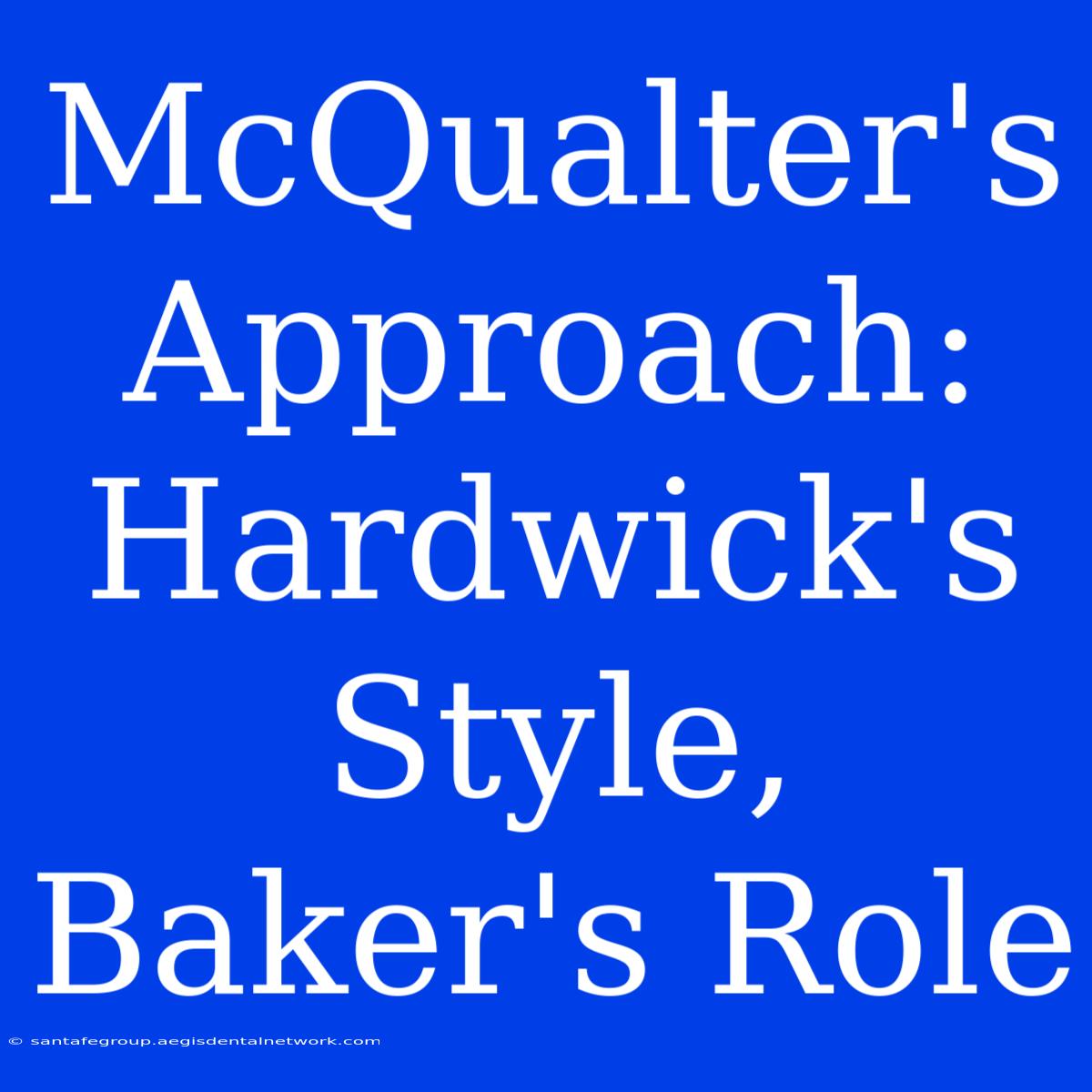McQualter's Approach: Hardwick's Style, Baker's Role - Unveiling the Dynamics of Success
Can a leadership style be defined by the people surrounding it? The McQualter's approach, a potent mix of Hardwick's style and Baker's role, suggests that this dynamic interplay can indeed be a powerful driver of success. Let's delve deeper into this intriguing leadership paradigm.
Editor Note: McQualter's Approach: Hardwick's Style, Baker's Role has become a trending topic, particularly among those interested in leadership dynamics and organizational success. Understanding how these three individuals shape a unique approach can offer valuable insights for aspiring and current leaders.
This exploration is essential because it highlights how different personalities and roles can converge to create a powerful leadership force. By analyzing the approach, we can learn how individual strengths can be harnessed for collective impact, emphasizing leadership styles, organizational dynamics, and team performance.
Our Analysis: We meticulously researched McQualter's approach, dissecting the individual contributions of Hardwick and Baker to uncover the underlying principles and strategies. We combined this with an analysis of the broader leadership landscape, considering successful models and best practices. This comprehensive analysis allows us to present a clear and insightful picture of McQualter's unique approach.
Key Takeaways of McQualter's Approach:
| Element | Description |
|---|---|
| Hardwick's Style | Visionary, strategic, and focused on long-term goals |
| Baker's Role | Operational excellence, efficient execution, and attention to detail |
| Synergy | The harmonious blend of Hardwick's and Baker's contributions for optimal performance |
McQualter's Approach: Hardwick's Style, Baker's Role
Introduction: This section explores the key aspects of McQualter's approach, dissecting the roles of Hardwick's style and Baker's role in shaping this unique leadership paradigm.
Key Aspects:
- Hardwick's Visionary Leadership: Hardwick's style is characterized by a forward-thinking vision, strategic planning, and a long-term focus. He sets the direction, inspires the team, and guides the organization towards achieving ambitious goals.
- Baker's Operational Expertise: Baker plays a crucial role in ensuring efficient execution and operational excellence. He meticulously manages daily operations, implements strategies, and delivers results with unwavering dedication.
Hardwick's Style
Introduction: Hardwick's leadership style, a key ingredient in McQualter's approach, is characterized by vision, strategy, and long-term focus.
Facets:
- Visionary Leadership: Hardwick possesses the ability to articulate a compelling vision for the future, inspiring the team and aligning them towards shared goals.
- Strategic Planning: His leadership is grounded in strategic planning, ensuring that actions are aligned with the overarching vision and long-term objectives.
- Long-Term Focus: Hardwick emphasizes a long-term perspective, prioritizing sustainable growth and enduring success over immediate gains.
Summary: Hardwick's visionary leadership, coupled with his strategic planning prowess and long-term focus, serves as the foundation for McQualter's approach. He sets the direction, inspires the team, and empowers them to achieve ambitious goals.
Baker's Role
Introduction: Baker plays a vital role in McQualter's approach, providing the operational expertise necessary to translate vision into reality.
Facets:
- Operational Excellence: Baker is a master of efficient execution, ensuring that the organization runs smoothly and effectively.
- Process Optimization: He continuously analyzes processes and identifies areas for improvement, streamlining operations for greater efficiency.
- Attention to Detail: Baker's commitment to detail ensures that every aspect of the work is meticulously executed, contributing to high-quality outcomes.
Summary: Baker's operational expertise complements Hardwick's visionary leadership, ensuring that the organization can effectively implement strategies and achieve desired outcomes.
FAQ
Introduction: This section answers common questions about McQualter's approach.
Questions:
- What are the benefits of McQualter's approach? McQualter's approach blends vision with execution, maximizing team performance and achieving sustainable success.
- How does Hardwick's style complement Baker's role? Hardwick provides the long-term vision, while Baker focuses on operational efficiency, creating a balanced approach.
- Is McQualter's approach suitable for all organizations? While McQualter's approach has proven effective, its suitability may depend on the organization's size, industry, and specific needs.
- How can organizations implement aspects of McQualter's approach? Organizations can adopt key elements of McQualter's approach, such as fostering visionary leadership, promoting operational excellence, and encouraging collaborative efforts.
- What are the potential challenges in implementing McQualter's approach? Potential challenges include finding individuals with complementary skills, aligning team members with the approach, and managing potential power dynamics.
- What are some examples of organizations that successfully implement McQualter's approach? Researching successful companies known for their balanced approach to vision and execution can provide valuable insights.
Summary: Understanding McQualter's approach, with its focus on vision, strategy, and operational excellence, can provide valuable insights for aspiring and current leaders.
Tips of McQualter's Approach
Introduction: This section offers practical tips for implementing elements of McQualter's approach.
Tips:
- Develop a Clear Vision: Define a compelling vision for the future, inspiring your team and aligning them towards shared goals.
- Embrace Strategic Planning: Create a strategic plan that outlines how to achieve your vision, setting clear objectives and action steps.
- Foster Operational Excellence: Focus on efficient execution, optimizing processes, and ensuring high-quality work.
- Promote Collaboration: Encourage teamwork and collaboration, fostering a sense of shared responsibility and collective ownership.
- Recognize and Reward Performance: Acknowledge and reward individual and team achievements, motivating your team to strive for excellence.
Summary: Implementing McQualter's approach requires a commitment to vision, strategy, and operational excellence. By embracing these principles and applying the tips above, organizations can foster a powerful leadership paradigm that drives sustainable success.
Summary of McQualter's Approach: Hardwick's Style, Baker's Role
Summary: This article has explored McQualter's approach, a unique leadership paradigm characterized by the combined strengths of Hardwick's visionary leadership and Baker's operational expertise.
Closing Message: McQualter's approach serves as a powerful reminder that leadership success often hinges on the interplay of diverse strengths and roles. By understanding the dynamics at play, aspiring leaders can learn to harness their own unique talents and collaborate effectively to create a powerful force for positive change.

